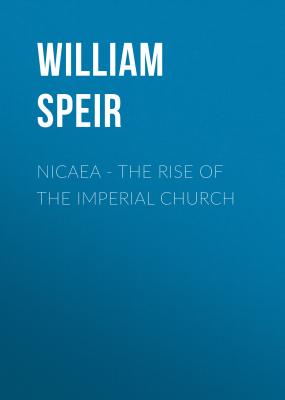ТОП просматриваемых книг сайта:
Nicaea - The Rise of the Imperial Church. William Speir
Читать онлайн.Название Nicaea - The Rise of the Imperial Church
Год выпуска 0
isbn 9781946329219
Автор произведения William Speir
Издательство Ingram
Nicaea
The Rise of the Imperial Church
By
William Speir
No part of this publication may be reproduced, stored in a retrieval system, or transmitted in any form or by any means, electronic, mechanical, photocopying, recording, or otherwise, without the written permission of the publisher.
Text Copyright © 2017 William Speir
All rights reserved.
Published 2017 by Progressive Rising Phoenix Press, LLC
www.progressiverisingphoenix.com
ISBN: 978-1-946329-21-9.
Printed in the U.S.A.
Cover Artwork by René Aigner, Munich, Germany
(http://www.rene-aigner.de). Used by permission of the artist.
© Copyright 2016 René Aigner.
Cover design by William Speir
Visit: http://www.williamspeir.com
Interior design by Polgarus Studio
Visit: http://www.polgarusstudio.com
Table of Contents
Acknowledgments
I want to thank all of my loyal readers, without whom I would not enjoy the creative process of writing.
Thanks to Amanda Thrasher and Jannifer Powelson at Progressive Rising Phoenix Press for believing in my books.
Special thanks goes to my editors, critiquers, and beta readers for their valuable edits.
Deepest gratitude goes to my wife for giving me the freedom of pursuing my passion. She is truly the love of my life. I am also grateful for my family, without whom there would be no words worth writing.
To Betty Jacobs for teaching me that real history is a complex set of cause-and-effect relationships, not just cold dead facts.
To Dr. Stephen O. Glosecki for teaching me comparative religion between classes at UAB.
To Nancy Fischer for helping me understand the historical context of the passages in the King James Version of the Bible and for first explaining about the Council of Nicaea.
To Jean S. Hebenstreit for showing me The Way.
The four of you have had a profound impact on my life, and I miss you all very much.
Author’s Notes
Arias of Baucalis is a fascinating historical figure. In all of my research, no one other than Judas Iscariot has been so vilified as has Arias. He has been called the anti-Christ and a heretic, possession of his writings was punishable by death, and he was considered to be so dangerous that he was exiled from the Roman Empire and then assassinated when the Emperor allowed him to return.
What was Arias’ crime? Why did he deserve such harsh treatment by historians over the centuries? He disagreed with other priests and bishops on key points of theology – points that the Roman Emperor wanted to become part of the theology of the churches.
Arias and his supporters stood up against an attempt to usurp church doctrine and transform the churches into a tool of statecraft, rather than allow them to remain institutions of salvation. In the end, Arias couldn’t withstand the might of the bishops in league with the Emperor. Because Arias lost the fight, and winners write the history books, Arias’ viewpoints have been altered and ridiculed by theologians and historians.
This book looks at Arias in a different light. Was he a good man whose principles didn’t allow him to go along with the Emperor and his supporters? Was he a sincere follower of the words and works of Jesus – a priest who wanted to preserve what he felt was the true religion of Christ? I believe that he was.
I have attempted to peel back the dogma and look at the central characters in the Arian controversy as real people, not as pious historical caricatures created by historians to delude the masses. I hope that I’ve been successful.
William Speir
June 2016
A Note on the Organization of the Early Churches:
The early Christian churches didn’t have the same structure as today’s religions. The early Christian churches, collectively, were a loose association of congregations that banded together for mutual interests

